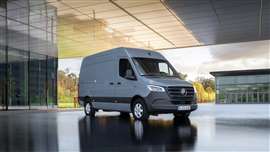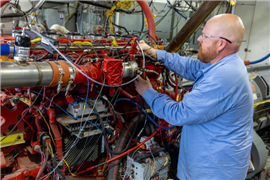Read this article in Français Deutsch Italiano Português Español
UK to reclassify battery-electric vans as light vehicles
26 November 2025
 With a GVW of up to 5.5 tonnes, models such as the Mercedes-Benz eSprinter were classified as HGVs in the UK (Photo: Mercedes-Benz)
With a GVW of up to 5.5 tonnes, models such as the Mercedes-Benz eSprinter were classified as HGVs in the UK (Photo: Mercedes-Benz)
The Department for Transport (DfT) is to reclassify some battery-electric (BE) vans in the UK as Class 7 MOT light vehicles instead of requiring the full HGV (heavy goods vehicle) test. The MOT is an annual inspection to confirm vehicles are roadworthy, looking at brakes, tires and other safety-critical systems.
Despite being the same size as vans fitted with internal combustion engines, BE vans had been classified as HGVs due to the weight of the battery packs pushing GVW to between 3.5 and 4.25 tonnes.
This meant that the BE vans were subject to more stringent testing criteria covering road worthiness, while the vehicles were also required to have equipment such as tachographs for calculating driver hours and speed limiting systems.
Companies have reported that the HGV classification served as a barrier to adoption of the zero-emission vehicles, due to the disproportionate financial and operational obligations.
Changes will see new BE vans only requiring an annual MOT test after three years (and every following year), instead of the one year required for HGVs. This will help reduce testing costs and having the vehicles off the road.
The DfT is also looking at whether the requirement for tachographs and speed-limiting equipment should be changed.
Lobby group the BVRLA had led the initiative for BE vans to be reclassified as part of its Zero Emission Van Plan.
Toby Poston, BVRLA chief executive said: “This is a great result for the van sector and delivers something the Zero Emission Van Plan has pushed up the agenda. Policymakers have listened to the fleet sector. We now need to see the legislation passed quickly to finally remove these restrictive regulations.
“Today’s progress underlines what can be achieved when an industry comes together with a shared voice, met by Government representatives that are ready to listen. Operators of large vans are being given the chance access cleaner, greener models, no longer hamstrung by illogical operational loopholes.”
Other changes brought about by the BVRLA with regards to BE vans include an extension of the Plug-in Van Grant, removal of the five-hour training requirement for 4.24-tonne vans, and support for depot and cross-pavement (sidewalk) charging solutions.
POWER SOURCING GUIDE
The trusted reference and buyer’s guide for 83 years
The original “desktop search engine,” guiding nearly 10,000 users in more than 90 countries it is the primary reference for specifications and details on all the components that go into engine systems.
Visit Now
STAY CONNECTED




Receive the information you need when you need it through our world-leading magazines, newsletters and daily briefings.
CONNECT WITH THE TEAM













